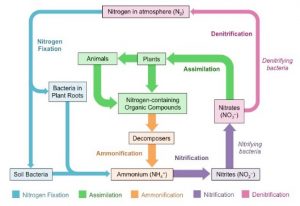NITROGEN CYCLE: A BIOGEOCHEMICAL CYCLE
Nitrogen Cycle is a process to convert inert nitrogen molecule into forms like nitrates and nitrites which can be taken up and used to make the required molecules.
The Nitrogen fixing bacteria: These are free-living or are associated with some species of dicot plants.
Fixation of nitrogen: Fixation of free nitrogen into compounds takes place by following means:
- Certain blue-green algae and bacteria can fix atmospheric nitrogen.
- Nitrogen fixing bacteria found in the nodules of roots of legumes such as gram, bean, pulses, etc., fix atmospheric nitrogen into containing compounds.
- Lightening also helps in the formation of nitrogen containing compounds.
Nitrogen Cycle Process
The processes involved in a complete nitrogen cycle are:
- Nitrogen fixation
- Atmospheric nitrogen is converted into the usable form by lightning strikes or symbiotic bacteria known as Diazotrophs.
- These bacteria consist of a nitrogenase enzyme which has the capability to combine gaseous nitrogen with hydrogen to form ammonia.
- Ammonification
- When plants or animal die organic nitrogen is again released back into the soil which is converted back into ammonium by bacteria or fungi present in the soil. This process is also called as mineralization.
- Assimilation
- It enters the food cycle when primary producers take in this gas from the soil with the help of their roots in the form of amino acids, nitrite ions, nitrate ions or ammonium ions. Then the consumers eat the plants.
- Nitrification
- The ammonia is converted into nitrate by the presence of bacteria called Nitrobacter in the soil.
- This conversion is very important because ammonia gas is toxic for plants. Ammonia is oxidized to form nitrites by bacteria such as Nitrosomonas species.
- Denitrification
- The nitrites are reduced back to inert nitrogen gas in this process.
- This is done by bacterial species such as Clostridium and Pseudomonas in the absence of oxygen, and this completes the nitrogen cycle.

